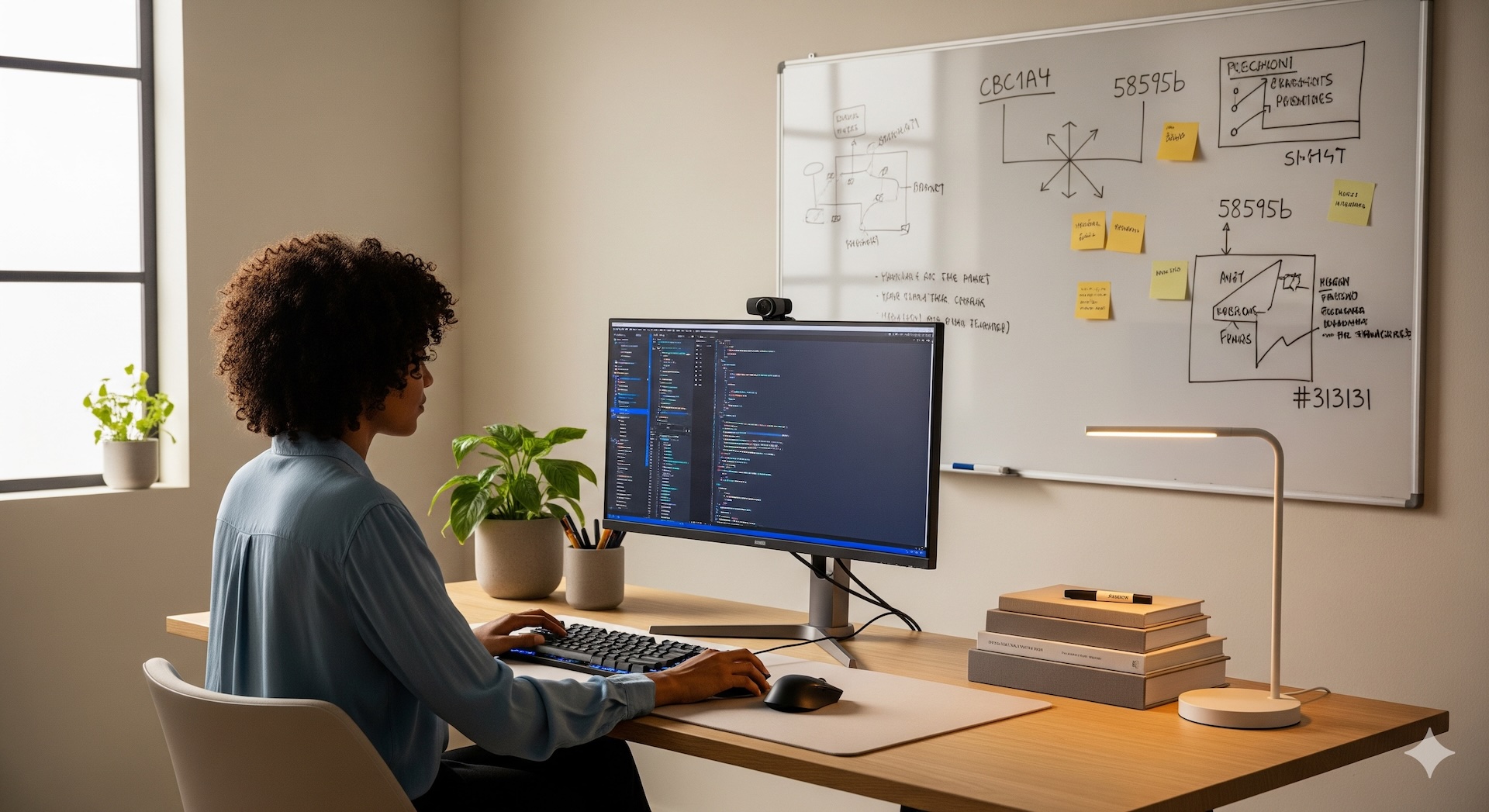Reading Time: 4 minutes
I was drowning in chaos.
Picture this: I’m on a Zoom call with a potential client, trying to share my screen to walk through a proposal, when I realize my presentation is buried somewhere in the digital haystack of my desktop. Meanwhile, my calendar notifications are pinging, I’ve got seventeen browser tabs open, and I’m frantically switching between windows like I’m playing some twisted game of digital whack-a-mole.
Sound familiar?
Here’s what I learned: You can have the most sophisticated AI tools in the world, but if your physical workspace is chaos, you’re still going to feel like you’re piloting a starship with a broken navigation system.
The Moment Everything Changed
Three years ago, I made what seemed like a simple decision: I bought a second monitor. Just a couple hundred bucks for another Acer to sit next to my main display.
That single purchase transformed my entire operation.
Now when I’m on client calls, I can run my presentation on the main screen while keeping Zoom, my calendar, and my task list visible on the secondary monitor. No more frantic window-switching. No more “can you see my screen?” moments. I can throw research windows, AI chat interfaces, or my email over to that second screen whenever I need them.
It sounds simple, but it gave me something precious: mental bandwidth. Instead of juggling digital windows, I could focus on the conversation, the strategy, the human connection.
Your Workspace Is Your Co-Founder
Here’s the thing most solopreneurs get wrong: We obsess over our digital tech stack – which CRM, which AI tools, which project management platform – but we treat our physical workspace like an afterthought.
Your office isn’t just where you work. It’s your co-founder. It either supports your vision or sabotages it every single day.
Think about it: How much time do you waste hunting for that one cable? Squinting at a tiny laptop screen during important video calls? Dealing with that pile of receipts you keep meaning to organize?
Every minute you spend fighting your environment is a minute stolen from your actual mission.
The Three Game-Changers That Cost Less Than You Think
1. That Second Screen (The Game-Changer)
I cannot overstate this enough. If you’re doing any kind of client work, content creation, or strategic planning on a single monitor, you’re operating with one hand tied behind your back.
For under $300, you can double your digital real estate. Use the main screen for your primary work, and let the second monitor become your “mission control” – calendar, tasks, chat apps, research windows. Your AI tools become infinitely more useful when you can reference them without losing your place in your main document.
2. A Document Scanner (The Chaos Killer)
Stop taking pictures of receipts with your phone. Just stop.
For about $150, you can get a compact scanner that turns that mountain of paper into searchable, organized digital files. Feed those receipts into your expense tracking system. Scan contracts and let your AI assistant help you summarize key terms. Turn business cards into actionable contacts.
The goal isn’t just organization – it’s making your information instantly accessible to both you and your AI teammates.
3. Noise-Canceling Headphones (The Focus Fortress)
Your attention is your most valuable asset. Protecting it is non-negotiable.
Good noise-canceling headphones aren’t just for music – they’re your fortress against the chaos of the world. Whether you’re writing your next blog post, strategizing your content calendar, or diving deep into AI prompt engineering, those headphones create a bubble of focus that’s worth its weight in gold.
I use mine even in a quiet office. There’s something psychological about putting them on that signals to my brain: “It’s time to do the important work.”
The Minimalist’s Dilemma
Here’s where most solopreneurs go wrong: They think more gear equals more productivity.
Wrong.
Every additional device, cable, or gadget is a decision you have to make. Where does it go? How does it connect? What happens when it breaks?
The secret is ruthless simplicity. One printer that does everything well, not three that do different things poorly. One charging station for all your devices, not cables scattered across every surface. One place for everything, so you’re not playing hide-and-seek with your tools.
Remember: Your workspace should reduce cognitive load, not add to it.
Making Smart Investment Decisions
Here’s the beautiful thing about optimizing your physical workspace: Most of these improvements pay for themselves quickly. That second monitor? It saves you hours every week. The scanner? It eliminates the Friday afternoon receipt-hunting expeditions that used to drive you crazy.
And here’s a pro tip: Before you buy anything, check Capital One Shopping. I’ve saved hundreds of dollars on office equipment just by comparing prices across retailers. Why pay full price when you don’t have to?
The Real Secret
Your physical workspace isn’t just about productivity – it’s about identity. When you walk into a well-organized, intentionally designed space, you’re not just a person with a laptop anymore. You’re a professional. A strategist. Someone who takes their mission seriously.
Your AI tools are incredible, but they’re only as effective as the human operating them. And that human – you – deserves a command center that supports your biggest ambitions, not just your daily survival.
What’s one change you could make to your workspace this week that would eliminate a daily frustration? Start there. Your future self will thank you.
Related
Discover more from The Social Media Hat
Subscribe to get the latest posts sent to your email.


